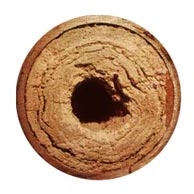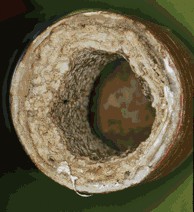FAQ = Frequently Asked Questions
 Incrustation in drain pipes of flush urinals
Incrustation in drain pipes of flush urinals
As early as 1956, during the first discussions about the installation of waterless urinal systems in the Federal Republic of
Germany, the question was examined whether there would be disadvantages in terms of deposits of so-called urine scale
in the drain pipes. These tests of existing systems have refuted these fears.
...
By the Heilbronn Chemical Research Institute, Dr.K. Schiller, it was clearly clarified on February 15, 1958 that the urine
scale in the waste pipes of the trade school came from the flushing water. It says: The piece of pipe contains large amounts
of yellowish-gray deposits and is therefore overgrown almost to the middle.
...
According to the present findings, these are essentially insoluble lime and magnesium compounds, which are present
in the form of carbonates, oxalates, phosphates and sulfates. Although the nitrates, chlorides and sulfides are soluble in
water, they are retained by the other deposits. Lime and magnesium are only contained in small amounts in urine. A large
part probably comes from the rinse water; insoluble lime and magnesium salts have formed through reaction with the substances present in the urine.
Fazit:
Incrustations are the deposition of poorly soluble chemical compounds on the inside of pipes as a result of
physical-chemical processes. More specifically, it is the calcium and magnesium carbonates in the dishwashing
water. Urine is merely the catalyst that triggers or accelerates this process. The incrustations reduce the pipe cross-section.
AND:
Incrustations only occur at a certain mixing ratio. This is also the reason why the problems usually only occur in the urinal's collecting pipe
gives. Incrustations no longer form in the downstream downpipe. So much water is added from the other consumers that the mixing ratio is no longer correct.

Incrustations are often confused with sedimentary deposits.
There are only low flow velocities within the siphons of waterless urinals due to the lack of water flushing and the relatively
small amounts of urine. Depending on the design, this inevitably leads to the sedimentation of solids within the siphon inserts
(dust, pubic hair, medications, ingredients from the blood that are excreted in the urine, etc.) and thus to the silt and clogging
of the siphon or the drain line..
By using the double flap membrane technology, the urine is drained away quickly without leaving any residue. We have also
integrated a sediment inhibitor in the siphon, which minimizes deposits in the drain line.
